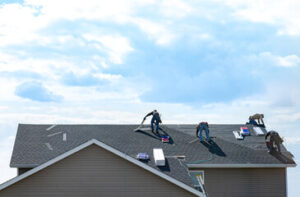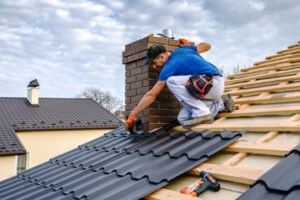Your roof is one of the most important parts of your home. It protects you and your family from the elements and adds to your curb appeal.

To keep it in good condition, you should inspect it regularly for any damage or signs of wear. If repairs are needed, you should consider having a professional roofing contractor install a new roof.
The first step in a successful roofing installation is to evaluate your roof and determine what type of material you want. Your friendly roofing contractor can help you select the best shingles for your home, whether you want dimensional shingles to add beauty and curb appeal, three-tab shingles to save money, wood shakes for a natural look or metal sheeting for durability. The next step is to install the underlayment and felt paper. This is important to keep water from seeping into your house. It will also help protect your new roof from the elements.
Once the underlayment and felt paper are in place, a roofer can start to put on the shingles. A professional will start at the bottom of your roof and work his way up to the ridge, making sure to cover the whole area. He will also waterproof the valleys, which are the areas where your roof slopes meet.
As he works, a roofer will remove any old shingles and debris from the roof. This is essential, because any debris left on the roof can interfere with your new roof’s installation and lead to leaks later. He will also clear any obstructions from the roof, such as satellite dishes or other objects.
The pounding of hammers on the roof can cause vibrations that may dislodge or damage items in your home. To avoid this, you should take down wall hangings and move delicate mementos and knickknacks to a safer location during the roof installation process. It’s a good idea to also backup any computer files, and cover any furniture that could be damaged by dust and dirt.
Finally, it’s a good idea to place tarps in the yard to protect landscape and garden areas from falling shingle debris. A tarp will also provide a barrier between your yard and the construction zone to prevent debris from getting into your neighbors’ yards and homes.
You should also make sure that your family members are aware of the noise and activity that will be taking place during the roofing installation process. If you have children or pets, be sure to keep them away from the construction site and find safe accommodations for them during this time.
Installation
The roof installation phase is the time when the actual shingles are laid. It can be a lengthy process, depending on the size of your home and type of roofing material. Once your roofing contractor has gathered all the necessary materials for your project, they will cover sensitive areas of your property with tarps and/or wooden boards to protect things like your driveway, pool, or landscaping. This will allow the debris from the roof to fall to the ground instead of damaging your possessions or landscaping.
The next step is to lay down the starter strip, which has a continuous adhesive on it that helps defend your roof against water intrusion. Then the first row of shingles are nailed down overlapping and offset from the previous row by 6 inches. This is to ensure that the tabs of adjacent shingles never line up. A pattern of overlapping and nailing is repeated until the ridge is reached. The roofer will also install vents, skylights, and chimney flashing, as well as ice and water shields in the valleys and along hip roofs.
After the roof is fully shingled, the contractor will apply a layer of roofing caulk around raw edges to make them waterproof. This will seal out the elements and prevent leaks in the future. They will also use roofing cement to seal the underlayment and shingle seams.
Cleanup
Depending on the scope of the roofing project, a roof replacement or significant repair can leave behind an unattractive mess of old shingles, scraps, nails and other debris. These materials can pose serious safety hazards to people or pets that come into contact with them, and can damage the surrounding property if not properly cleaned up.
A well-executed cleanup process is an important part of a successful roofing job and should be outlined in the roofing contractor’s contract. This ensures that the cleanup will be a priority and eliminates any surprises down the road for the homeowner.
When hiring a roofing contractor, make sure they include the cleanup process in their contract and read customer reviews to find out how well they performed. The better the cleanup process, the less of a mess and stress you will have to deal with after the job is done.
The first step in cleaning up a re-roofing project is to cover sensitive areas of the home and yard with tarps, such as air conditioning units, plants, patio furniture, lawn ornaments and driveways. This helps to prevent any debris and mud from getting on these items or being tracked inside the house. Having a roll-off dumpster onsite also helps during the roofing job, as all of the debris can be thrown away immediately instead of letting it pile up.
After the tarps are in place, it is time to start the actual work of removing and replacing shingles. For this, the crew will have to tear off the existing shingles and underlayment. This is where a lot of the debris will accumulate, including old shingle nails that can puncture and tear the new shingles. Having a nail sweeper on hand is a good idea, as it will help to remove most of the nails but may not catch every last one. A magnetic sweeper will also be helpful, as it can pick up any stray nails that may have missed the nail sweeper.
It is also a good idea to have a downspout bag installed in the gutter, as this will keep any small debris, such as nails, from washing into your yard and garden beds. This can be especially beneficial for homeowners with young children and pets that will be playing in the yard during the roofing project.
Warranty
Generally speaking, warranties combine the laws of strict liability and negligence with contract law to provide consumers with protection against defective products. Warranties can be express or implied, and can cover both parts of a product and the labor needed to make repairs. Always carefully read the fine print of a warranty to ensure that you know exactly what is and is not covered. You may also want to do a quick Internet search on the company offering the warranty to check its reputation.
